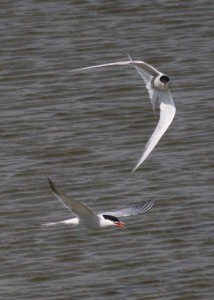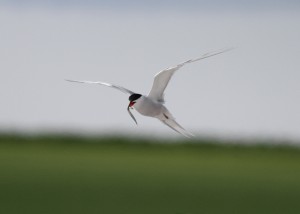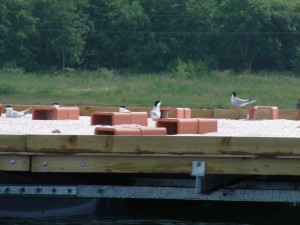Behaviour 101: Common Terns
With the tern raft camera permanently streaming online, minus a few hitches, there’s been the perfect opportunity to watch the Common Terns and all the behaviours connected to this time of year. These behaviours can be broken down into two main types, territorial and breeding.
Territorial

Common Terns are highly territorial when it comes to their nest sites, not surprising when they’re only 20 inches (50 cm) wide. Selected by the male a few days after he arrives, he will defend the site from both sexes until the female returns (though if she’s more than five days late he will accept another female in her place). He will carry on this defensive role until the chicks have fledged and will repel any land intrusions by producing alarm calls, opening his wings, raising his tail and lowering his head to show off his black cap. In most cases this will work, with the intruder showing its throat in submission and leaving the area, but when it doesn’t the male will stop calling and attack the intruder with bill grappling and jabbing. Aerial intruders don’t get the luxury of warning displays and will simply be attacked. All this aggression disappears though when a predator is spotted and the colony will join together to repel the threat. Interestingly, unlike many birds that nest in colonies, any wandering chicks are tolerated by the adults at different nest sites and will be left unharmed by the adults.
Breeding

Common Terns will usually pair with the same individual each year and confirmation of the pair’s bond starts with the aerial courtship as males and females fly in wide circles, calling to each other, before descending in a zig zagged glide to the nesting site. When on the ground the male starts by circling the female with his tail and neck raised, head pointing down, and wings partially opened and lowered. Once the female has reciprocated with the same display they will end with both their heads pointing up. Males may also bring fish to the female to cement the bond, but will not allow her to take it until she has displayed sufficiently. That’s assuming she’s there, of course. There have been a number of times where the webcam has shown males returning, fish in bill, to find himself standing alone staring blankly around for his mate, before flying off fish still in bill.

Once the courtship displays have been completed the male will then make a shallow depression in the substrate they are nesting on before moving to allow the female to inspect the spot and copy the process. This produces a saucer shaped scrape, which can be seen on the webcam, and several trials on slightly different locations will be tried before the pair settle on one and start laying eggs.
Despite the terns being very protective of their nest site and young, the crows on the tern raft have shown little fear of them and have already taken a number of eggs. This may be due to the fact that Common Terns are far less aggressive than the famed attackers the Artic Terns and will not actually hit the intruder but swerve at the last minute instead. Interestingly, though, Common Terns are able to recognise individuals and will attack those they are familiar with more often than strangers. Even with the lack of actual hits, it’s probably not a comforting thought for our ranger.
Georgina Bowie (Visitor Centre Assistant)
Help protect Scotland’s wildlife
Our work to save Scotland’s wildlife is made possible thanks to the generosity of our members and supporters.
Join today from just £3 a month to help protect the species you love.
Preface
With the tern raft camera permanently streaming online, minus a few hitches, there’s been the perfect opportunity to watch the Common Terns and all the behaviours connected to this time …
